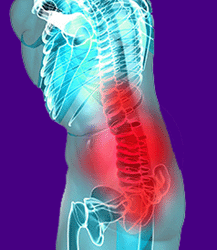Facet Syndrome (FS) is a painful condition of the back that is a common problem in patients with chronic neck and backache. Read and learn all about the causes, symptoms, diagnosis and treatment of this musculoskeletal disorder.
What is Facet Syndrome?
Page Contents
It is a type of pain affecting the facet joints, the synovial joints that are located in pairs on both sides of the vertebrae. These joints are covered by a thick lubricating liquid known as synovial fluid and function as hinges connecting the spinal vertebrae. Each of the joints are lined by a special membrane called synovium and also enclosed within a fibrous sac known as the joint capsule. A special type of tissue, the articular cartilage, lines the bony surfaces of the facet joints. Abnormalities occurring within various anatomical parts of facet joints may give rise to pain and thereby threaten the overall stability of the spinal column. This painful condition is referred to as Facet Syndrome or Facet Joint Syndrome.
Facet Syndrome Types
The disorder is classified into several types depending upon the location of the pain.
Picture 1 – Facet Syndrome
Lumbar Facet Syndrome
Also referred to as ‘Lumbar Facet Joint Syndrome’, it is a type of pain caused by the arthritis of facet joints in the lower back or lumbar region of the spinal cord. The pain may even stretch to the buttock as well as the upper thigh regions.
Cervical Facet Syndrome
It is characterized by the structural weakening of the vertebrae joints that are located in the cervical section of the spine around the neck. It is also known as Cervical Facet Joint Syndrome or Cervical Facet Disease. This form of osteoarthritis most frequently occurs later in life. It can cause significantly high chronic pains if ignored or left untreated.
Thoracic Facet Syndrome
It is a degenerative spinal condition which causes significant back pain as well as other health problems if left untreated. It is also called Thoracic Facet Disease. A vital responsibility of the thoracic spine vertebrae is to provide support to the ribcage. Just as the lumbar and cervical segments are meant to provide flexibility, the thoracic spine is aptly structured for providing stability. Over time, the cartilage coating on the facet joint fades away which results in arthritic pain due to bone-on-bone contact and facilitates growth of osteophytes.
Lumbosacral Facet Syndrome
It is a debilitative spinal condition that affects the lower back and the pelvis regions. If left untreated, it can lead to acute pain around the lower half of the body. Due to the flexibility and smoothness of the spine section as well as the pressure of supporting most of the body weight, Lumbosacral Facet Syndrome is quite common.
Posterior Facet Syndrome
Also referred to as Posterior Facet Disease, it is a detrimental condition of the spine which causes chronic neck and back pain. This syndrome is mostly associated with aging and is generally experienced much later in life, only after several years of wear and tear have taken its toll on spinal column.
Facet Syndrome Symptoms
It is rather difficult to exactly pinpoint the symptoms of FS due to their high similarity with effects of other major spinal conditions. The most prominent symptoms of FS or spinal arthritis include wearing away of the smooth cartilaginous lining of spinal joints. This leads to friction between the vertebral bones that can give rise to bone spurs. The lower back or lumbar and the neck or cervical areas of the spine are most susceptible to this type of bone erosion, these being the most flexible regions of the spine and enduring the maximum stress over the lifetime of a person.
Some of the other notable signs and symptoms of FS include:
- Sporadic pains
- Headaches
- A dull, deep ache
- Inflammation of the facet joints
- Difficulty in turning the neck or twisting the lower back region
- Difficulty in leaning forward
- Tenderness near the inflamed joints
- Stiffness in the neck and lower back regions after getting up in the morning
Damage or deterioration of the facet joints, due to age or any other reason, can result in acute pain. The cervical and lumbar regions are most vulnerable to this condition. FS symptoms are experienced in varying extremities, depending on the areas that are affected.
Facet Syndrome Causes
Injuries or age-related changes in the bone structure leads to swelling of bones or erosion of the cartilaginous covering of facet joints. This results in increased friction within joint space and consequently, development of painful symptoms. A degenerative disc disease may lead to reduced disc height and cause stress within the facets on the same levels. This can ultimately lead to FS.
The symptoms of FS may be produced due to age-related deterioration of cartilage that exposes small nerves lying within the joints. FS symptoms may also arise due to the formation of osteophytes or bone spurs, which are a form of bony projections developed by reduced stability of joints. In most cases, these bone spurs remain asymptomatic. However, they can also grow big enough to irritate the nearby nerve roots. This can weaken the muscles, thereby causing pain, tingling sensation and numbness.
Facet Syndrome Prevention
FS cannot be prevented under normal conditions as it occurs as a natural consequence of aging. However, even though a patient cannot prevent the predominant causes of the disorder, he or she can definitely keep his or her spine healthy by following certain regulations and avoid development of degenerative spine conditions in this way. The health of spine may also be safeguarded in the following ways:
- Maintaining a proper body weight
- Eating the right kinds of food
- Exercising regularly
- Avoidance of smoking
- Following other general healthcare tips
An FS patient may also try some gentle stretching, hot and cold therapy, physical therapy and appropriate pain-relieving medications (analgesics) to mitigate the symptoms of the disease in an effective manner. One may also try some alternate treatment methods such as yoga, acupuncture, Pilates and massage therapy to relieve the pain and keep the negative effects of FS under control.
Facet Syndrome Diagnosis
The diagnosis of FS is done only after a thorough physical examination as well as a careful study and analysis of the medical history of a patient. Additional tests and examinations may be used for ruling out the possibilities of other disorders such as a herniated or fractured disc as the source of pain. Such tests include:
- X-Ray
- CT (Computed Tomography) scans of the spine
- MRI (magnetic resonance imaging) scans
The medial branch block exam is regarded as the best diagnostic test for FS. It is conducted under the influence of X-Ray by injecting an anesthetic medicine into or close to the nerves which are connected to the facet joint. If the pain decreases considerably after a numbing medication is implemented, the patient is confirmed to be suffering from FS. If the injection does not reduce the pain, it is improbable that the facet joints are a cause for the pain in the level in which the numbing injection was administered.
Facet Joint Syndrome Treatment
While dealing with FS, doctors often recommend conservative treatment options at the initial stages of cure. These include:
- Taking pain-relieving medications
- Cold/hot therapy
- Performing some physical exercises
- Taking proper rest
The medications that are generally prescribed by doctors include NSAIDs, Opioids and Facet Joint blocks, which are anesthetic and steroidal medication injections. Patients can also try out alternative treatment options such as:
Picture 2 – Facet Syndrome Image
- Yoga
- Pilates
- Acupuncture
- Massage therapy
- Aromatherapy
- Chiropractic adjustments
In most cases, FS is easily handled by various treatment options discussed above. Doctors opt for surgery only when these treatment methods are unable to ease the pain of FS.
Facet Syndrome Prognosis
This condition is mostly kept under control by following conservative treatment procedures. In most cases, these procedures successfully help in minimizing painful symptoms. Patients can lead a healthy life albeit he or she might have to follow certain regulations, such as maintaining special postures while sitting or standing and regularly performing some exercises. In very rare cases, surgery is chosen as the treatment method. In case of surgery, prognosis varies from one patient to another.
FS frequently occurs with the onset of age as the cartilage covering of facet joints wear away with years of wearing and tearing. This causes significant pain to an individual. However, following some simple procedures can allow a person to control the pain and lead a normal life.
References:
http://www.painmd.com/types-of-pain/backspine/facet-syndrome.html
http://en.wikipedia.org/wiki/Facet_syndrome
http://www.laserspineinstitute.com/back_problems/facet_syndrome/
http://www.bonati.com/conditions/Facet-Syndrome/
http://knol.google.com/k/lumbar-facet-syndrome#
http://www.spine-health.com/conditions/arthritis/symptoms-and-diagnosis-facet-joint-problems


